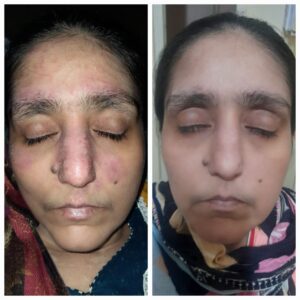Airborne Contact Dermatitis
What is Airborne Contact Dermatitis?

Airborne contact dermatitis (ABCD) is a morphological diagnosis that encompasses all acute or chronic dermatoses predominantly of exposed parts of body, which are caused by substances which when released into the air, settle on the exposed skin. Although the diagnosis of ABCD is not difficult for the trained eye, finding the causative contactant and the treatment of the resultant clinical condition may prove to be a challenge for the treating dermatologist. Contact dermatitis is designated as “airborne” on the basis of the history of the patient and the follow-up, existence of dust or of volatile causative agents, the morphology and distribution of the lesions and the results of epicutaneous tests.
Symptoms of Airborne Contact Dermatitis
Signs and symptoms of contact dermatitis vary widely and may include:
-
An itchy rash
-
Leathery patches that are darker than usual (hyperpigmented), typically on brown or Black skin
-
Dry, cracked, scaly skin, typically on white skin
-
Bumps and blisters, sometimes with oozing and crusting
-
Swelling, burning or tenderness
Causes of Airborne Contact Dermatitis
The common allergens and irritants which have been demonstrated to produce an airborne dermatitis like picture are listed in Table 1.[1,20–32] These include various acids and alkalis, metals and powders of metallic salts, cement, industrial solvents, glass fibers, sewage sludge, ammonia, vegetable and wood allergens, plastics, rubbers and glues, insecticides, pesticides, animal feed additives and many others. The airborne contactants can also be classified on the basis of their physical state as volatile airborne contactants like acids, alkalis, ammonia and pesticides; droplets like insecticides, perfumes and hair sprays; powders which include aluminum, anhydrous calcium silicate, and metallic oxides; and particles like tree sawing particles, wool and plastics.
Risk of Airborne Contact Dermatitis
- Airborne contact dermatitis is a type of skin inflammation that occurs when the skin comes into contact with certain allergens in the air.
- Common airborne allergens that can cause contact dermatitis include pollen, mold, dust mites, fragrances, cleaning agents, and solvents.
- People who are already prone to allergies or have a history of allergic reactions are more likely to develop airborne contact dermatitis.
- Individuals who work in industries such as agriculture, construction, or healthcare, where exposure to various allergens is common, are also at a higher risk.
- Symptoms of airborne contact dermatitis can include redness, itching, swelling, and blistering of the skin. In severe cases, it can lead to breathing difficulties, asthma attacks, or anaphylaxis, a life-threatening allergic reaction.
- To reduce the risk of airborne contact dermatitis, it is essential to identify and avoid exposure to allergens. Wearing protective clothing, gloves, and masks can also help reduce the risk of exposure to allergens.
- If you experience symptoms of airborne contact dermatitis, it is essential to seek medical attention immediately.
Ayurvedic Treatment for Dermatitis
Dermatitis Treatment Before & After Results






